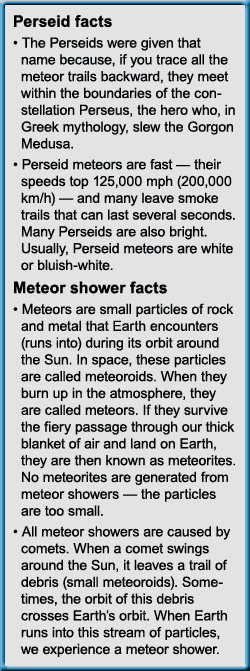
WAUKESHA, WI – The annual Perseid meteor shower is typically one of the year’s best. In 2007, this shower will be especially good because it peaks August 13 under a dark New Moon. Moonlight won’t wash out faint meteors. So, observers will see both bright and faint “shooting stars” easily.
Bright, fast meteors, many of which leave smoke trails visible for several seconds, characterize the Perseid meteor shower.
Astronomy magazine editors are available to discuss this spectacle. To request an interview, please contact Matt Quandt at 262.798.6484 or mquandt@kalmbach.com.
“This is a great event for the whole family,” says Astronomy magazine Senior Editor Michael Bakich. “Viewing a meteor shower doesn’t require any equipment, the event is active during a long period of time, and it happens in the summer.” The best time to see the meteors is when the Perseids peak, at 4 a.m. EDT August 13. New Moon occurs 7 hours earlier.
August 13 isn’t the only date to observe Perseid meteors. This year, the shower will be active between about July 17 and August 24. Of course, observers will see fewer meteors the further they observe from the peak.
Viewing tips
A clear, dark sky will reveal more than just a few Perseids. “Dark” means at least 40 miles from the lights of a large city. No telescope is required – in fact, the eyes alone work best because they provide the largest field of view. Observers at a dark site should average a “falling star” each minute.
Early in the evening on Sunday, August 12, set up a lawn chair, preferably one that reclines. Face east, and look halfway up. After midnight, adjust the chair, and generally look overhead. Glancing around won’t hurt anything.
In addition to a chair, observers should bring a blanket, bug spray, cookies, fruit, and a non-alcoholic beverage. Alcohol interferes with the eye’s dark-adaption as well as the visual perception of events.
This year, with no Moon in the sky, observers can expect to count between 60 and 100 meteors per hour from a dark site.
Astronomy news
This week’s sky events
Astronomy basics
Glossary of astronomical terms
Return to Astronomy “For the media” page
Astronomy‘s mission:
Astronomy promotes the science and hobby of astronomy through high-quality publications that engage, inform, entertain, and inspire.









